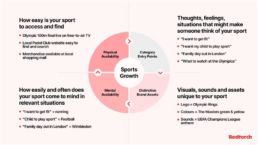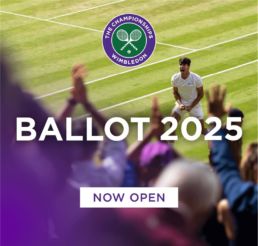I’ve worked in sports marketing for over 16 years and when people talk about ‘growing their sport’ they’re usually always talking about one of the following:
more fans, more participation, more engagement or more sales.
But if you want your sport to truly grow – to reach beyond the few and capture the minds (and wallets) of the many – you need to embrace some of the unsexy laws of marketing.
This means looking beyond “performance marketing” and short-term wins, and embracing the principles behind how to drive long-term and sustained growth for your sport.
Start with the Fundamentals: How Sports Grow
These are the essential building blocks needed for your sport to grow – more people will follow it, participate in it and support it.

Understand your audience triggers (Category Entry Points)
Category entry Points (CEPs) are the thoughts, feelings or situations (internal and external) that might make someone think of your sport. CEPs are critical because they influence which sports are initially thought of in the relevant situations.
A great example: beer in an Irish pub > Guinness.
For a sport to grow, start by identifying the most frequent and relevant CEPs for your audience. Then, build fresh, strong and distinctive associations between your sport and those CEPs. Different sports come to mind in different situations; your sport will grow by coming to mind more easily in more situations.
- “I want to get fit”
- “I want my child to play sport”
- “Family day out in London”
- “What to watch at the Olympics”
Make your sport recognisable and distinctive (Distinctive Brand Assets)
These are your sports unique assets (like a logo, colour or sound) that enable people to instantly recognise and link your sport. The key here is to consistently link your sport’s DBAs back to as many CEPs as possible.
Rather than focusing on trying to communicate how your sport is different via your DBAs, I like to focus on what Ehrenberg-bass calls “meaninglessly distinctive” – a view that the primary function of DBAs is to make your sport instantly recognisable and memorable, rather than communicating unique benefits or complex messages.
Use your DBAs relentlessly, consistently and without compromise to build recognition among both existing and future fans. Ultimately, knowing you exist isn’t enough: you need to be easy to find, easy to consume, easy to remember.
- Logo = Olympic Rings
- Colours = The Masters green & yellow
- Sounds = UEFA Champions League anthem
Ensure your sport comes to mind easily (Mental Availability – the result of points 1 & 2)
While generic brand awareness is a good starting point, being able to recall your sport without context isn’t much use (someone knowing your sport exists doesn’t mean they’ll choose it to either play, watch or follow it).
This is where ‘mental availability’ comes in. Coined by Ehrenberg-Bass Institute, mental availability is the likelihood of a sport coming to mind in a variety of buying (moment of choice) situations. It goes deeper than mere awareness and is all about the breadth and depth of memory structures related to your sport.
- “I want to get fit” = running
- “I want my child to play sport” = football
- “Family day out in London” = Wimbledon
Make your sport easy to get (Physical Availability)
Physical availability means how easy it is for someone to find or buy your sport’s product or services (e.g., buy tickets, join a local team or club, or visit a website for more information).
For sports, this translates to making your core “product” – the sport, event or content – accessible to the broadest possible audience. If you’re serious about growing your sport, you have to maximise these points of physical availability to ensure that whenever and wherever a fan wants to engage with your sport, the path to do so is clear and convenient.
- Olympic 100m final live on free-to-air TV
- Local Padel Club website easy to find and navigate
- Team merchandise available at local shopping mall
The Overarching Challenge: Why These Fundamentals Are Crucial
It’s not just about what you do, it’s about understanding the actual battle you’re fighting, which is often different to what you think it is.
Indifference is your biggest challenge
Your competition doesn’t only include other sports; it’s also Netflix, gaming, the latest viral video and every other demand on people’s time. Your competitors almost certainly aren’t who you think they are, and your primary battle is against apathy, not fierce rivals.
Example: If you and a friend have a free, warm and sunny Sunday and think, “what shall we do this afternoon?” you’ll choose between various options – related to sport or not. The harsh reality is that you’re most likely not getting chosen, not because it’s a choice between you and another sport, but because you were never in the day one consideration set in the first place.
Strategic Mindset & Implementation: How to Build Effectively
Shift your approach to increase market penetration and expand your reach.
People don’t always choose the “best”; they want something “good enough that they trust”
Focus less on convincing people your sport is superior and unique and more on being seen and front of mind (distinctive). Think, “Hey! We’re here, you can trust us and we’re kinda good.”
• Example: Nike. The biggest sports brand (probably), the best distribution (possibly), but is it demonstrably the best product? In many cases, no. Especially in certain apparel and equipment categories.
Be everywhere (within reason)
Even on tight budgets, it’s important to maximise your reach across as many relevant channels as possible. Don’t be overly precious about where your brand appears: he more people who see your distinctive assets, the better.
• Example: Don’t get sucked into the hyper-target world of one or two social media platforms. If you want to grow, get visible across as many platforms as your budget allows.
“There is really only one way that brands sustainably grow, and that is they grow by expanding their customer base, which means more of all types of buyers roughly in the proportion that you have.
And so when you document how brands grow over time, you see that much more change happens in the number of buyers they have than the weight of purchase or the loyalty of those buyers.” – Jenni Romaniuk, Ehrenberg-Bass Institute
Context trumps personalisation:
Although personalisation has its place, the vast majority of your marketing budget should prioritise reaching broad audiences in appropriate contexts. It’s more effective for growth when people are receptive, rather than having to try and guess their individual preferences.
• Example: The NFL Super Bowl is a cultural phenomenon. Brands invest huge sums on ads to reach millions of Americans from diverse backgrounds and cultures. The goal isn’t to personalise a message, but to create a highly distinctive and memorable ad that broadly links the brand to a universal category entry point (like a “celebration” or “social gathering”).
Justifying Investment & Sustaining Effort: The Long-Term View
Understand why consistent investment in brand building pays off.
Brand building amplifies performance marketing
All of the above talks about how a brand grows, but I’m well aware we live in a world where the powers that be often want immediate financial returns and therefore don’t want to invest in brand building. This is understandable – it’s hard to measure – but wrong.
For starters, building a strong, well-known brand (through long-term broad-reach activities) increases the effectiveness and efficiency of your immediate performance marketing (e.g., ticket sales). When people already know and trust a sport, they are more likely to attend its events, visit its website and buy its merch.
• Example: Think of how Wimbledon delivers consistent and emotive broad-reach ads that aren’t specifically asking people to “buy now”. Now think about when Wimbledon opens its ballot for tickets (sales)… what impact do you think the brand-building ads will have on ticket sales? Yup, a big one.

Advertising doesn’t “wear out”
Some of the points above might fill those working in comms/creative with dread. The thought of using the same DBAs over and over again, delivering the same simple message over and over again… no thanks. Unfortunately for them, the idea that your audience gets bored with your ads is largely a myth as consistent, broad-reach advertising with simple and consistent use of DBAs builds memory structures. Don’t pull a campaign because you think it’s been seen too many times; if the creative is good enough, keep pushing it to reach new potential fans.
• Example: Imagine how bored the internal team at KitKat must be having to use its slogan “have a break” all the time. Good – it’s a sign your ads are working as the reality is no one will care about your sport’s advertising – or see it – as much as you do.
Measurement: Proving What Works
Don’t guess; track your progress to validate your strategy.
Brand tracker: measure effectiveness
Please, please, please implement a brand tracker – and talk to real people – to monitor the effectiveness of your brand-building activities. It’s the only genuine way to monitor the impact of your brand marketing, so it’s vital that the C-suite continue investing in it! Stop guessing; implement robust brand tracking to assess mental availability, distinctive asset recognition, and salience. This isn’t vanity; it’s essential to understand if your marketing is actually working.
“If you’re not tracking your brand then you’re not managing your brand.” – Mark Ritson, Founder MiniMBA
• Example: Establish a base level outlining what people think about your sport and what they associate it with. Does it align with what you want them to think? If not, work hard at changing these perceptions and links, then monitor again. Is there a positive change? If yes, your brand marketing is working.

So there you have it, a few fundamental marketing truths that – if applied to sport – will give you the best chance of growth, whether that’s participation, ticket sales, social media, or anything else.
Marketers love to make things complicated, but the reality is the path to sustained growth is clear:
It starts with mastering the fundamentals of how your sport gets remembered and easily accessed (Category Entry Points, Distinctive Brand Assets, Mental and Physical Availability). From there, it’s about confronting indifference as your biggest challenge, adopting a broad and contextual strategic mindset, amplifying your efforts through consistent brand building, and critically, measuring your impact to ensure continuous investment.
Good luck and if you need any support or outside perspective … I’m always happy to help.
About Alex
Alex Ross is Co-founder of Redtorch.
With over 15 years’ experience in the sport industry and MBAs in both Marketing and International Relations, he has personally developed hundreds of global marketing and brand plans.
Alex works directly with senior leaders across a wide range of sports organisations – from global federations like World Aquatics, UCI, ISU, FEI and World Athletics to brands like Longines.
Passionate about cutting through the jargon, he applies marketing fundamentals to deliver honest and effective strategies with a dedicated and friendly approach.
About Redtorch
Redtorch is an independent Research & Creative Agency. We help brands punch above their weight. Born in Olympic sport, we thrive under pressure – small teams, high stakes, global eyes. That’s why so many brands trust us to grow audiences, deliver high-performance creative and turn cultural signals into a winning advantage.
Ultimately, in a world where getting and keeping attention is harder than ever, we’re passionately dedicated to making sport more relevant.
Alex Ross
I'm a sport-obsessed film lover with a passion for evidence-based marketing. I'm proud to own an agency that's become one of the most trusted in world sport.
My most memorable sporting moment is …
Spectating: Liverpool beating AC Milan in 2005 to win the UEFA Champions League.
I am happiest when …
With family.
The sports person that best represents me is …
Frederik Fetterlein (Danish Tennis player... worth a google).
The three things at the top of my bucket list are …
1. Complete an Ironman for the charity MIND
2. Learn a (new) language
3. Work with the NFL
A quote I try to live my life by is …
"Life is as good as the memories you make."





